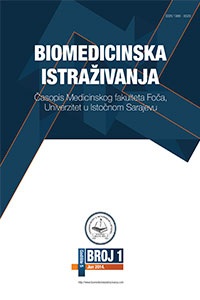Classification of patients at risk for chronic kidney disease by use of eGFR and albuminuria
DOI:
https://doi.org/10.7251/BII1501028SAbstract
Introduction. Screening for chronic kidney disease (CKD) has been advisedin high-risk populations. However, data on the prevalence of early asymptomatic
stages vary and depend on the definition of CKD. In the present study
subjects at risk for CKD (patients with diabetes mellitus type 2-DM2, with
hypertension and older than 60 years without diabetes and hypertension)
were classified in categories defined by eGFR and albuminuria staging system.
Methods. After regular check-up in primary health center, 285 consecutive
patients at risk for CKD, were selected: 75 patients with well-controlled DM2
without hypertension, 130 with hypertension and 80 subjects older than 60
years without diabetes or hypertension. Screening included a questionnaire,
blood pressure measurement, single albuminuria determined by immunonephelometry,
and eGFR estimation using MDRD.
Results. Six DM2 patients, 15 withe hyprtension and 12 elderly had eGFR<60
(assessed in ml/min/1.73m2) with optimal albuminuria. High albuminuria
was observed in one DM2 and four hypertensive patients, and 28 elderly.
When eGFR and albuminuria staging system for predicting risk for major
CKD outcomes was used, 41.2% of the elderly were classified in the moderate
and 8.8% in the high risk group, for DM2 patients these percentages were
9.3% and 0%, and for hypertensive patients 16.9% and 4.7%, respectively.
Conclusion. The majority of examined patients did not have CKD, and in all
three groups most individuals with reduced eGFR did not have albuminuria
>30mg/g. Using the classification of CKD based on eGFR and albuminuria,
Downloads
Published
2015-07-23
Issue
Section
Чланци

